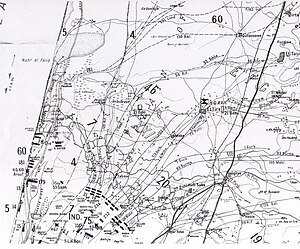| Battle of Sharon | |||||||
|---|---|---|---|---|---|---|---|
| Part of the Middle Eastern theatre of World War I | |||||||
 Falls Map 20 Detail shows capture of Nahr el Faliq and clearing of the coastal plain for the cavalry advance, the attack on the Tabsor defences and the advances towards Tulkarm and Et Tire | |||||||
| |||||||
| Belligerents | |||||||
|
|
| ||||||
| Commanders and leaders | |||||||
|
|
| ||||||
| Units involved | |||||||
|
| ||||||
| Strength | |||||||
| 35,000 infantry, 9,000 cavalry, 383 guns | 40,598 infantry | ||||||
| Casualties and losses | |||||||
|
XXI Corps 3,378 casualties including 446 killed Desert Mounted Corps 125 killed, 408 wounded or missing | More than 3,000 dead and wounded, unknown casualties from aerial bombing, more than 25,000 prisoners | ||||||
The Battle of Sharon fought between 19 and 25 September 1918, began the set piece Battle of Megiddo half a day before the Battle of Nablus, in which large formations engaged and responded to movements by the opposition, according to pre-existing plans, in the last months of the Sinai and Palestine Campaign of World War I. The fighting took place over a wide area from the Mediterranean Sea east to the Rafat salient in the Judean Hills. Here the Egyptian Expeditionary Force (EEF) XXI Corps with the French brigade sized Détachement Français de Palestine et de Syrie attacked the Yildirim Army Group Eighth Army's XXII Corps and German Asia Corps. The Battle of Sharon extended well behind the Ottoman front lines when the Desert Mounted Corps rode through a gap in the front line across the Plain of Sharon to occupy the Esdraelon Plain. Meanwhile, during the Battle of Nablus the XX Corps attacked Nablus while Chaytor's Force held the right flank in the Jordan Valley before advancing to secure bridges and fords across the Jordan River, to continue the encirclement the defenders in the Judean Hills. Subsequently, Chaytor's Force advanced against the Fourth Army to capture Es Salt and Amman after the Second Battle of Amman.
The Battle of Sharon began on 19 September with a Western Front style bombardment during which two-thirds of the mainly ground-based heavy artillery, supported by the firepower of two destroyers pounded Ottoman positions, while one third of the heavy artillery fired creeping barrages to cover the infantry assaults. The XXI Corps infantry attacked simultaneously along the front line from the Mediterranean coast where the 60th Division, launched an attack on the western coastal section of the front line defended by the Eighth Army's XXII Corps. During this Battle of Tulkarm the 60th Division breached the front and second line trenches to eventually capture Tulkarm, the site of the Eighth Army headquarters. On their right, the main Tabsor system of trenches held by the Ottoman XXII Corps was attacked and eventually captured during the Battle of Tabsor, by the 3rd (Lahore), 7th (Meerut), and the 75th Divisions. These three divisions subsequently advanced, despite the Ottoman XXII Corps being reinforced, to capture Et Tire and Masudiye Station. In the process of the battles for Tulkarm and Tabsor the 7th (Meerut) and 60th Divisions created a gap in the front line, for the Desert Mounted Corps to ride through. They rode north and eastwards to the rear to capture the defending Ottoman armies' lines of communication. The right flank of the attacking XXI Corps was protected from the Eighth Army's Asia Corps, by the 54th (East Anglian) Division and the French Colonial Détachement Français de Palestine et de Syrie holding and pivoting on the Rafat salient, during the Battle of Arara as the infantry battle progressed.
The cavalry phase of the Battle of Sharon began as soon as the gap was made during the infantry attacks. The 5th Cavalry Division led the way north up along the Plain of Sharon followed by the 4th Cavalry Division with the Australian Mounted Division in reserve. These divisions subsequently rode across the Mount Carmel Range through two passes, to occupy the Esdraelon Plain, on 20 September. Here they cut the main Ottoman lines of communication. Units of the 4th and 5th Cavalry Divisions converged to capture Afulah with the 4th Cavalry Division capturing Beisan in the afternoon. The Australian Mounted Division captured Jenin along with thousands of prisoners when they captured the main line of retreat from Nablus to Damascus. On 20 September Nazareth, the site of the Ottoman Army's Yildirim Army Group headquarters, was unsuccessfully attacked by the 5th Cavalry Division. During the Battle of Nazareth the Ottoman Commander in Chief, Otto Liman von Sanders, was forced to escape. The 5th Cavalry Division captured the town the following day and several days later this division also captured Haifa and Acre following the Battle of Haifa. On the last day of the Battle of Sharon, the Australian Mounted Division attacked a German reinforced rearguard garrison at Samakh, which had been put on the alert by Liman von Sanders during his escape from Nazareth. The Australian Light Horse victory at the Battle of Samakh and the subsequent Capture of Tiberias ended the Battle of Sharon and the Battle of Megiddo. As a result of the battles of Sharon and Nablus, known collectively as the Battle of Megiddo, much territory and many prisoners were captured. The Final Offensive of the Sinai and Palestine Campaign began the day after the Battle of Megiddo ended, with the pursuit to Damascus, which was captured on 1 October.
